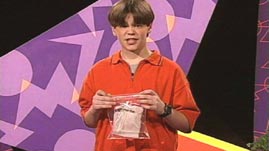Teachers' Domain - Digital Media for the Classroom and Professional Development
User: Preview


Source: ZOOM
Germinator (AD) (Video)
(humming)
(gasp)
HOST: Amanda H. of Sherwood, Arkansas, wrote to tell us how she loves experimenting with plants. So we thought it would be cool to show other ZOOMershow plants grow. So here's how to make...
VOICE (as Arnold Schwarzenegger): The Germinator.
HOST: The ingredients you'll need for the Germinator are: some seeds—we're going to use beans but you can use whatever; a paper towel; a stapler; a plastic bag-- the ones with the zipper works best; a ruler; and half a cup of water.
Okay, the first thing you do is, you take a paper towel and you fold it so that it fits into a plastic bag. I'm going to fold it into fourths. All right, now you measure three inches from the top of the plastic bag... And staple a row of staples. Five would be good, but make sure they're on the paper towel.
Okay. Now you take your half cup of water and pour it in so the seeds have something to drink. Now it starts to get heavy. Now you take four or five seeds and lay them across the row of staples. Make sure you could see them. Zip up your bag so no air can get in and no air can escape. Make sure you can see your seeds, so you can watch them...
VOICE: germinate.
HOST: Tape your bag to a window where it's light or tape it in a closet where it's dark. Try it in both places. Does it work better in the light or the dark area? Here's one that's already germinated and here's one that hasn't yet germinated. Maybe it needs more time or maybe it will never germinate. Until later.
VOICE: Hasta la vista, baby.
 Loading Standards
Loading Standards Teachers' Domain is proud to be a Pathways portal to the National Science Digital Library.
Teachers' Domain is proud to be a Pathways portal to the National Science Digital Library.
